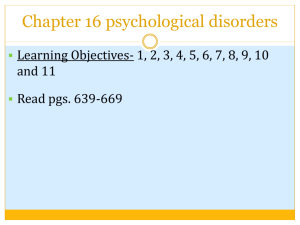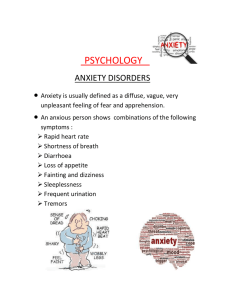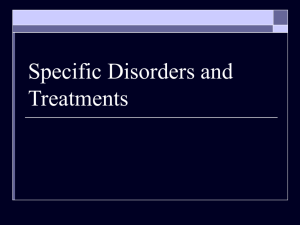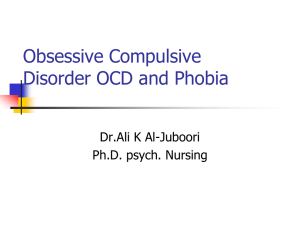Chapter 18 Section 2 - Putnam County Schools
advertisement
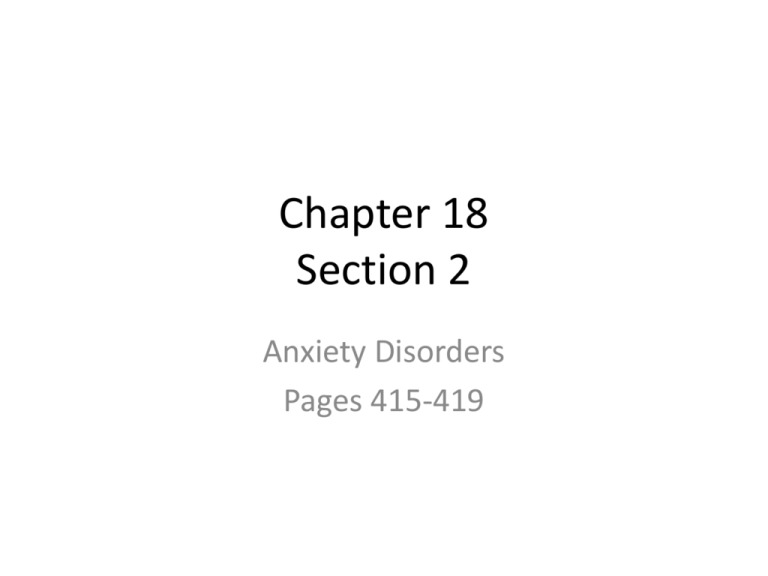
Chapter 18 Section 2 Anxiety Disorders Pages 415-419 Objectives • Distinguish among the anxiety disorders, and outline the theories that explain them. Phobias • Research the proper names for as many phobias as you can locate. • Examples: hydrophobia: fear of water; brontophobia: fear of thunder and lightning; ergophobia: fear of work. • You may be amused by some of the more unusual phobias, but please understand that almost any object or situation may lead to a phobic reaction in certain individuals. OCD and Shopping Addiction • Now that you have viewed MTV True Life: OCD and Shopping Addiction. Describe the root of the behaviors of the people in the shows. Compare and Contrast the young people in the True Life and how they worked towards getting healthy. Anxiety • Anxiety is the general state of dread or uneasiness that occurs in response to a vague or imagined danger. • Anxiety is typically explained by nervousness, inability to relax, and the thought of losing control. Physical signs and symptoms trembling, sweating, rapid heart rate, shortness of breath, increased blood pressure, flushed face, and feelings of faintness or light-headness. Types of Anxiety Disorders • Phobic Disorder- Phobia-comes from the Greek root phobos, which mean “fear.” • Simple Phobia-persistent excessive or irrational fear of a particular object or situation. • To be diagnosed as a phobic disorder, the fear must lead to avoidance behavior that interferes with affected person’s normal life. • Social phobia-people with social phobias fear all social situations; others fear specific situations, such as public speaking, eating in public, or dating. Generally try to avoid the situations they fear. Invent excuses to avoid going to parties or other social gatherings. Panic Disorder and Agoraphobia • Panic attack-have recurring and unexpected panic attacks. Intense fear or discomfort, shortness of breath, dizziness, rapid heart rate, trembling or shaking, sweating, choking, nausea, or other physical symptoms. • The attack may last a few minutes to a few hours. Some feel they may by dying or going crazy. Generalized Anxiety Disorder • GAD-excessive or unrealistic worry about life circumstances that lasts for at least six months. Worries focus on finances, work interpersonal problems, accidents, or illness. • Many do not seek psychological treatment. Obsessive-Compulsive Disorder • Obsessions-unwanted thoughts, ideas, or mental images that occur over and over again. • Compulsions-repetitive ritual behaviors, often involving checking or cleaning something. • Stress Disorders- Post-traumatic stress disorder: intense, persistent feelings of anxiety that are caused by the an experience so traumatic that it would produce stress in anyone. Examples: rape, child abuse, assault, severe accident, airplane crash, natural disasters, and war. • Symptoms: flashbacks, nightmares, numbness of feelings, increased tension, and avoidance associated with trauma Activity Page 418 • Read the feature and then describe the types of stress and anxiety that many Americans felt after the attacks of September 11, 2001. Consider how these symptoms might be similar to or different from those experienced by persons who survive a natural disaster such as a flood, earthquake, or tornado. Chart • Create a two-column chart summarizing the psychological and biological explanations of anxiety disorders. • Write a paragraph discussing which explanation they believe best explains anxiety disorders and why.



